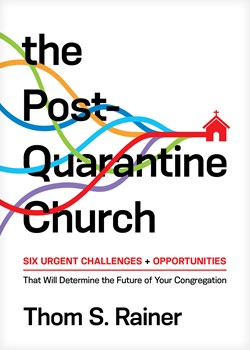Excerpted from The Post-Quarantine Church by Thom Rainer
The early days of the quarantine were often filled with concern and confusion for church leaders. What are we going to do if we can’t gather in person? How can we make sure our church is sufficiently funded? How will we minister to people we can’t see in person? What do we do about our small groups?
The initial period of question upon question transitioned to a level of excitement as church leaders and members discovered the possibilities in the digital world. To be clear, they had been aware of this world (to varying degrees), but now they were seeing it with fresh eyes.
The immediate challenge, however, of now viewing the digital world as a mission field is that missionaries typically have a plan in place before they venture into a new field. For most church leaders, the effects of the pandemic were unexpected and sudden. Pastors and other leaders were unprepared and often confused about what to do next. Simply stated, they had no plan for this disruption. So the initial wave of questions and confusion followed by excitement soon led to more questions and confusion.
Before the pandemic, most church leaders were not concerned about reaching people in the digital world. They focused their attention on the opportunities available in person. After all, that was the mission field they knew and where they had been all their lives. That was the mission field for which they were trained.
But now things are different. Very different.

As church leaders finally began to think more seriously about reaching the digital world, restrictions eased in their communities and it became time to plan their reentry into the in-person world. Most leaders were consumed with physical preparations to reopen and making certain they took into consideration all the warnings and safety precautions.
But many of these church leaders and members had not forgotten their desire to reach people digitally. They had caught a glimpse of the opportunities during the pandemic, and now they wanted their post-quarantine church to make some bold moves. There was an intensified desire to move into this new mission field.
Perhaps you’re among them and you’re wondering what to do next. While once again acknowledging that it’s early in the post-quarantine era, and though we’re cautious about making definitive declarations, we can see some promising plans beginning to unfold.
At the core of many of these plans is a realization that churches must deal with three groups: what we’re calling digital only, digitally transitioning, and dual citizens.
The first group represents a digital-only presence, which could include people who are physically unable to attend in-person gatherings. They could be anyone from elderly shut-ins to members of the armed forces stationed overseas.
The digital-only group also includes people who may still consider it too risky to enter a church’s physical facilities because of COVID-19, and some who are simply unwilling or unready to attend a church service. They are not totally antichurch, but they’re not eager to gather with the in-person fellowship. Some may be willing to make that transition in the future; some may never take a step further. How will churches reach and minister to these people?

The second group are digitally transitioning people. They are still mostly connected to the church digitally. They rarely, if ever, attend an in-person gathering. But there are indications they are somewhat open to connecting in person. Perhaps they’ve joined a video-based small group and have begun to get to know others better. Perhaps they completed a digital connection card during a streaming service. A strategy to reach out to these people may include specific ways to encourage them to attend an in-person worship service.
The third group are the dual citizens. They are connected to your congregation both digitally and in person. This distinction is important to remember. It’s pretty rare anymore to find someone who has no digital connections, even if they strongly prefer in-person gatherings. Most people in North America have some level of digital presence. Indeed, I just liked a Facebook post by my eighty-four-year-old mother-in-law.
The future strategy for churches, therefore, must keep in mind these three groups.
So where do we begin?
Lessons on Prayer from the Early Church
Interestingly, the experience of the early church in Jerusalem is instructive for our forays into the digital world today. Though the means of communication were quite different, the need for faith was not.
Shortly before Jesus ascended to heaven, he told his followers, “You will receive power when the Holy Spirit comes upon you. And you will be my witnesses, telling people about me everywhere—in Jerusalem, throughout Judea, in Samaria, and to the ends of the earth.”
That was it. No other instructions. No strategic plan. No further clarity of purpose.
So what did they do when they didn’t know what to do?
They prayed.

The Bible indicates that the prayers of the early church were powerful because the people were of one mind: “They all met together and were constantly united in prayer.”
They didn’t know what else to do, but they knew they were supposed to pray.
It’s easy to become fascinated by the technological possibilities of this newly discovered digital mission field. But we must not allow them to undermine our commitment to prayer and seeking God’s guidance. It’s an exercise in futility to try to reach and minister to the digital world without prayer as a first step. It’s like trying to accomplish God’s mission without God.
Though we are not offering specific methodologies to guide your church in prayer, we strongly recommend that you keep in mind the three major groups we’re trying to reach in the post-quarantine era: digital only, digitally transitioning, and dual citizens.
How will you pray for each of these groups? What ways will you make available for the primarily digital groups to share prayer needs with you? How will you involve the dual citizens in praying for the other groups? How will your church leaders and members maintain an active and vibrant prayer ministry in the post-quarantine era?
It’s an exciting time. But if we attempt to move forward without prayer, the opportunity will quickly devolve from God-empowered to human-centered. The latter is a guarantee for failure.
 The Post-Quarantine Church by Tom Rainer
The Post-Quarantine Church by Tom Rainer
A trustworthy and respected guide for pastors and church leadership in the post-quarantine world, providing hope and vision for the future of your congregation.
From thousands of surveys of church leaders and in-person consultations, Thom Rainer and his Church Answers team have gathered the essential wisdom you will need to face the challenges and opportunities that the quarantine crisis creates for the local church, including:
– New and better ways to lead the gathered church
– A wide-open door for growing the digital church
– A moment to rethink the facilities
– New strategies for church growth . . . and much more!
This book is, in effect, your personal church consultant, helping you plan and prepare for the future. In the midst of heartbreak, tragedy, and struggle due to Covid-19, here’s hope, wisdom, encouragement and vision.
Order your copy of The Post-Quarantine Church here!




